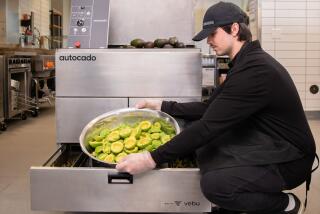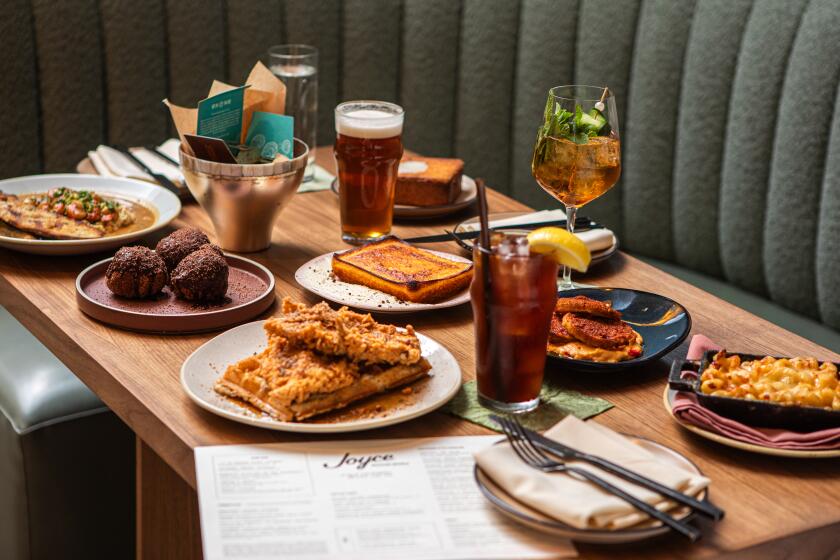A very special delivery
IT may be the most highly anticipated produce debut ever: Mangoes from India, banned from importation until the U.S. and India reached a trade agreement last year, have finally hit stores in Southern California.
Why all the excitement?
The mango, in India, is revered for its flavor and texture. “It’s luscious, it’s satiny, it’s smooth and velvety, and has the most elegant mixture of sweet with a little sour that you can possibly hope to find,” says Madhur Jaffrey, author of “Climbing the Mango Trees: A Memoir of a Childhood in India” and other Indian cookbooks.
Though hundreds of mango varieties are grown in India, only three -- Alphonso, Kesar and Banganpalli -- will be available in the U.S. this season. Alphonsos and Kesars were the first to arrive.
Alphonsos, smallish and golden-yellow, are amazingly sweet and succulent, with floral aromas and a creamy, fiber-free texture. Los Angeles-based produce wholesaler Melissa’s received a shipment the first week of May, says Robert S. Schueller, director of public relations for the firm. Although Melissa’s distributed them to retailers in Texas, Pennsylvania and New York, L.A. retailers didn’t bite, Schueller says, thanks to their high price -- they sell for $35 for a case of 12.
“We’re at the peak of mango season,” he says. “You can buy a dozen mangos of the Ataulfo variety for less than 10 bucks, so most retailers look at the price and say, ‘Oh, it’s probably not worth it.’ In a market where you can get two mangos for a dollar, and these are costing $4 or $5 apiece, it depends on where your priorities are.”
Mexican-grown Ataulfo mangos -- the only fiberless variety besides the Indian ones -- are available nine months of the year, he says.
But the high price doesn’t seem to be deterring Indian mango aficionados. Devraj Kerai, owner of Pioneer Cash & Carry, a grocery in Artesia’s Little India district, says he wanted to be the first to carry Indian mangoes in the region. He received 110 cases of Kesars (12 per case) on May 11, he says, and he sold out in three hours. (Since then he has received three more shipments of Alphonsos and Kesars, pre-selling them, with a waiting list.)
When I arrived at Pioneer that first day, there was a huge yellow and orange banner that screamed, “Indian Mangoes Now Available,” and the scene around the mango display was like a scrum. That’s not surprising to anyone who knows Indian culture.
“Mangos are an essential part of every Indian’s growing up,” says Jaffrey. “Every party for graduations has mangoes, because that’s also the time of the mango. The minute someone graduates, mangoes are sent, placed in a bucket of ice (the quickest way to cool a lot of them), and everyone sits around in a celebratory mood.
“At all our weddings, like a Jewish chuppa, we have a canopy, a mandap, that the couple stands under. The canopy is made of mango leaves, the most auspicious of leaves, and you are surrounded by their blessings.”
Still, eyes popped when Pioneer customers learned how expensive the mangoes were. A few snapped up cases, quickly ferrying them away. Others took a more cautious approach. One couple bought a single fruit for $3.50 and returned moments later to indulge in just one more. They had eaten the first one behind the store and couldn’t resist buying another.
Besides the price issue, mango devotees should consider that all Indian-grown mangoes exported to the U.S. are irradiated. The reason for the long ban was that they can harbor a pest -- the mango seed weevil -- but the weevil is killed with low levels of irradiation. “Irradiation is recognized as a safe and effective way of providing insect quarantine treatment,” says Christine Bruhn, an expert on irradiation and director of the Center for Consumer Research at UC Davis, but the procedure remains controversial.
In any case, I didn’t let it bother me: I couldn’t wait to taste one. The Kesars, a bit larger than the Alphonsos, are still green when ripe, with only a touch of yellowing, if any.
As I peeled the skin down the side of the fruit, a fabulous perfume wafted up: lime blossom, citrus and spice. I filleted the two “cheeks” away from the flat oval pit. The flesh was gorgeous, a beautiful, deep saffron color. (“Kesar” means saffron in Hindi.) I sliced, and tasted.
The flesh was silky and ripe, with a texture almost like tofu. It was amazingly sweet and deeply flavored, with funky tropical notes and a touch of bright lime and a gorgeous finish. Not wanting to miss a bit, I slurped the rest of the fruit over the sink.
Kesars will be available only through late June, and they’re not easy to find: The only stores carrying them in Southern California are a number of Indian groceries; meanwhile, Melissa’s is selling them online ($55 per case, plus shipping).
Banganpallis, grown in the south of India, are on their way says Pioneer’s Kerai; he expects to have them this week.
So are Indian mangoes worth the steep price tag? For Schueller, it’s a close call. His favorite, he says, is the green Keittmango, grown next to the Salton Sea in the Coachella Valley; they’ll come into season in July. “The Indian mangoes are just as good,” he says, “but the price is so high.”
But for me, it was the best $35 I’ve spent all year.
--
--
(BEGIN TEXT OF INFOBOX)
A wide world of flavor, texture and color
Indian mango varieties
Though there are hundreds of mango varieties grown in India, only three are available in the U.S.
Alphonso: Sweet, soft-fleshed and nearly fiberless, with golden yellow skin that may be blushed with red, this variety is well known throughout India. Harvested from March to June.
Kesar: Small to medium-size, it has a green skin that doesn’t necessarily change color when fully ripe. Check for ripeness with a delicate squeeze. It takes its name from the Hindi word for saffron, due to its spicy perfume and orange flesh. It is picked from May to June in its northern home state of Gujarat.
Banganpalli: Large, oval, and golden yellow, with a distinct aroma. Peeling its thin, smooth skin reveals a firm, meaty, fiberless, sweet yellow flesh. Harvested in southern India from April to June.
--
Mango varieties widely available in the U.S.
Tommy Atkins: Growers favor this large, colorful variety (its “blush” is mostly red) for good looks, a long shelf life and a fibrous flesh, which helps it endure global transit. Comparing apples to mangoes, this Red Delicious of the mango world has only fair flavor but is widely available through most of the year.
Haden: A descendant of the Tommy Atkins, this yellow-orange to red fruit is medium to large in size and known for its high sweetness and moderate fiber. It’s available October through June.
Kent: Large, with a greenish yellow skin and a bit of red blush, it has rich sweetness and nearly no fiber. Available October through April from South America.
Ataulfo: This small mango has a bright yellow skin and sweet, soft buttery flesh, and very little seed fiber. It’s sometimes called a Manila or Mexican mango and is also sold under the brand name Champagne. Available in the spring through early summer; now is peak season.
Keitt: Harvested green before full maturity, this very large fruit, developed in Florida, can be used for Asian green mango recipes. It can also be left to ripen to orange-yellow, for full-on eat-out-of-hand flavor. The season is May through September.
-- Shuji Sakai
--
In the market for Indian mangoes
THE following retailers sell Indian-grown mangoes. Prices average about $35 per case of 12, or $3.50 per mango, except where noted.
Pioneer Cash & Carry, 18601 Pioneer Blvd., Artesia; (562) 809-9433.
Ambala Cash & Carry, 18411 Pioneer Blvd., Artesia; (562) 924-1441.
Farm Fresh, 18551 Pioneer Blvd., Artesia; (562) 865-3191.
New Bombay Stores, 917 W. Foothill Blvd., Upland, (909) 981-9323; and 1385 Blaine St., Unit H3, Riverside, (951) 788-3042.
Bombay Bazaar, 3848 N. McKinley St., Corona; (951) 272-3820.
Melissa’s, www.melissas.com; (800) 588-0151; $55 per case, plus shipping.
-- Shuji Sakai
--
Mango and sticky rice
Total time: About 45 minutes, plus soaking time for the rice
Servings: 4
Note: Thai sticky rice or Japanese sweet (or mochi) rice can be purchased at Asian markets.
1 cup sweet rice (Thai sticky rice is preferred, but Japanese sweet rice will work)
1 (5.6-ounce) can unsweetened coconut milk
2 tablespoons sugar
1/4 Salt
2 ripe mangoes
Black sesame seeds for garnish
1. Soak the rice in water for at least 1 hour, preferably overnight. (The grains of rice must absorb moisture before cooking.)
2. Drain the rice. Line a bamboo steamer basket or the perforated bowl of a double boiler with a double layer of cheesecloth. Fill the base of the double boiler, or a wok if using the bamboo steamer, with water, making sure the top of the water does not touch the base of the steamer.
3. Bring the water to a boil. Reduce the heat to a gentle simmer and place the drained rice in the steamer. Cover and cook for about 15 minutes until done (it should be softer than al dente).
4. While the rice cooks, heat the coconut milk in a small saucepan over medium heat just until it begins to simmer, then turn off the heat. (Boiled coconut milk will curdle and separate.) Add the sugar and salt to the coconut milk, and stir until it’s dissolved.
5. When the rice has cooked, remove it to a medium bowl, and gently stir in half of the seasoned coconut milk using a spatula or wooden spoon. Cover and set aside for 5 minutes to allow the rice to absorb the coconut milk.
6. Peel the mangoes, and slice each cheek off the pit. Slice each cheek lengthwise in half and then crosswise into three-fourths-inch-thick slices. Into each of four small bowls, spoon one-half cup of the sticky rice, and gently drizzle the remaining coconut milk over each serving, about a tablespoon each. Arrange each sliced cheek of mango over the rice and sprinkle the top with black sesame seeds. Serve immediately.
Each serving: 300 calories; 37 grams protein; 54 grams carbohydrates; 3 grams fiber; 9 grams fat; 8 grams saturated fat; 0 cholesterol; 77 mg. sodium.
--
Mango sherbet with Sauternes
Total time: About 30 minutes, plus freezing time for the sherbet
Servings: 8
Note: The sherbet is adapted from “Chez Panisse Desserts” by Lindsey Remolif Shere. Shiso is available in the produce section of Asian markets. Barsac may be substituted for the Sauternes.
3 pounds very ripe mangoes (about 4), plus 1 mango peeled and finely diced (about 1/4 -inch)
3/4 cup sugar
Juice of 2 limes
2 shiso leaves, finely sliced into strips
1/4 cup Sauternes, divided
1. Peel the 3 pounds of mangoes and slice the fruit from their pits. Scrape as much pulp off the fibrous pits as you can. In a food processor, puree the fruit and pulp, about 2 minutes. Measure 3 1/2 cups from the puree and set it aside in a mixing bowl.
2. In a small saucepan, gently simmer the sugar with one-half cup water for 5 minutes over medium-low heat to allow the sugar to dissolve and the syrup to reduce slightly. Cool the syrup, then add it to the mango puree with the lime juice.
3. Chill thoroughly; then freeze according to the directions for your ice cream maker.
4. Scoop about one-half cup of the sherbet into each of 8 small bowls. Scatter 1 tablespoon of the diced mango over each serving and scatter the julienned shiso leaves evenly over the mango in each. Drizzle about one-half tablespoon of the Sauternes over each serving and serve immediately.
Each serving: 173 calories; 1 gram protein; 44 grams carbohydrates; 3 grams fiber; 0 fat; 0 saturated fat; 0 cholesterol; 3 mg. sodium.
--
Mango and shrimp salad
Total time: About 45 minutes
Servings: 4
Note: From Dawna Nolan. If there is leftover salad, it’s great wrapped in a large butter lettuce leaf the next day. Asian fish sauce (nam pla from Thailand or nuoc mam from Vietnam) is available at well-stocked supermarkets and Asian groceries.
Dressing
4 tablespoons fish sauce
2 tablespoons brown sugar
2 tablespoons honey
4 tablespoons fresh lime juice (from about 2 to 3 large limes)
2 cloves garlic, minced
2 to 4 seeded and minced Thai chiles (or 1 to 3 serranos), to taste
1. In a small saucepan, combine the fish sauce, sugar and honey. Heat over medium heat, stirring constantly, until the sugar and honey dissolve and the mixture is syrupy, about 1 minute.
2. In a blender or food processor, combine the sweetened fish sauce syrup, lime juice, garlic and chiles, and blend for about 30 seconds to a minute. Set aside. Makes two-thirds cup.
Mango salad and assembly
1 pound (medium to large) raw shrimp
5 to 6 large firm mangoes (about 8 ounces each), peeled, pitted and cut into medium dice
1 cup bean sprouts
2 tablespoons minced shallot (about 2 large)
About 1/2 cup stemmed cilantro, plus more for garnish
About 1/2 cup small mint leaves (if leaves are large, tear them in half), plus more for garnish
2/3 cup dressing, divided, or to taste
4 teaspoons chopped peanuts (unsalted) for garnish
Lime wedges
1. Peel and devein the shrimp under cold, running water. Bring a large saucepan of lightly salted water to a boil. Reduce the heat to a slow simmer and add the shrimp. Poach the shrimp until just cooked (they will be pink and firm, and opaque throughout), about 2 to 2 1/2 minutes. Drain the shrimp; place them in a bowl of ice water to stop the cooking. Drain the shrimp again; set aside in the refrigerator.
2. In a large bowl, combine the mangoes, sprouts, shallot, cilantro and mint and set aside.
3. Mix about one-half cup of the dressing, or to taste, with the reserved mango mixture. Mound the mango mixture on four chilled plates. Toss the shrimp with the remaining dressing to coat. Divide the shrimp evenly on top of each salad and sprinkle about 1 teaspoon peanuts on top of each plate. Garnish with sprigs of mint and cilantro. Add lime wedges to each plate.
Each serving: 388 calories; 27 grams protein; 66 grams carbohydrates; 7 grams fiber; 4 grams fat; 1 gram saturated fat; 172 mg. cholesterol; 1,223 mg. sodium.
More to Read
Eat your way across L.A.
Get our weekly Tasting Notes newsletter for reviews, news and more.
You may occasionally receive promotional content from the Los Angeles Times.










